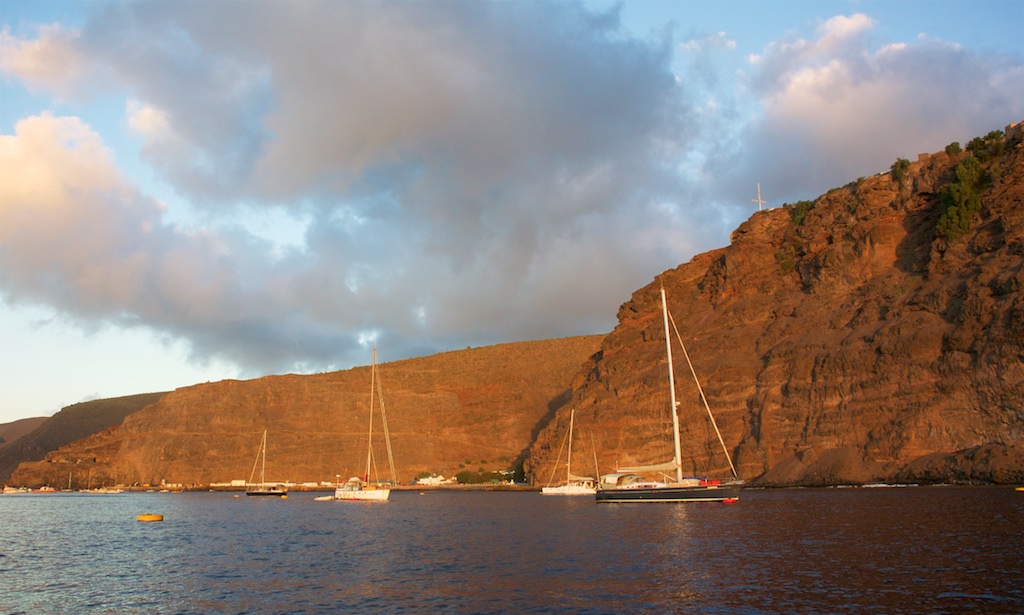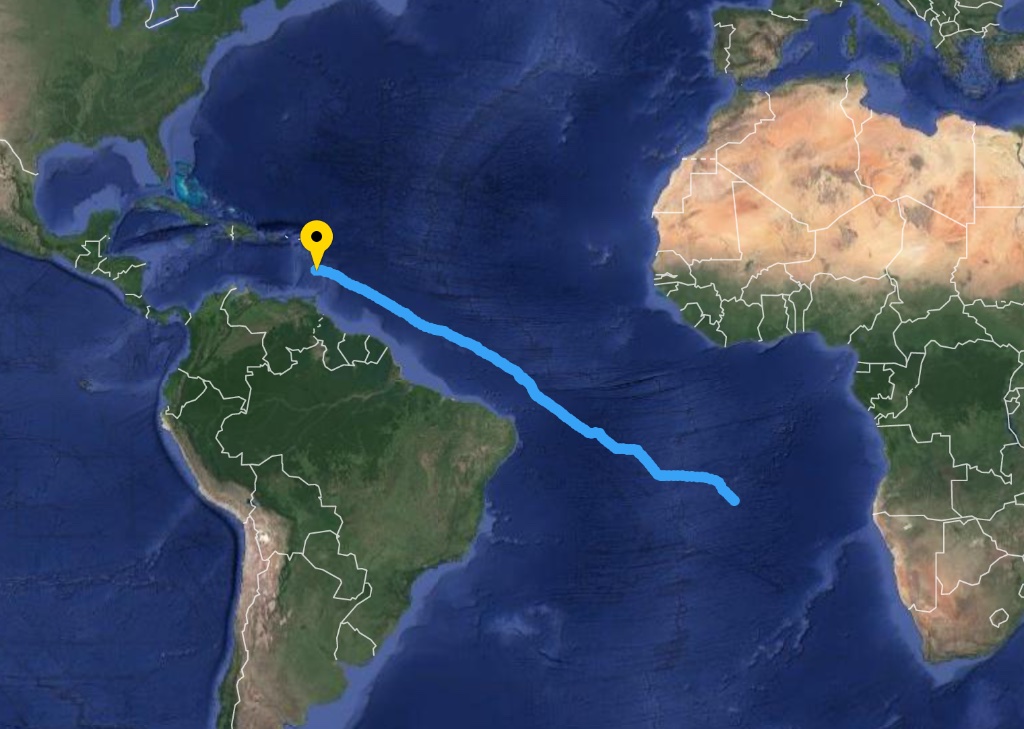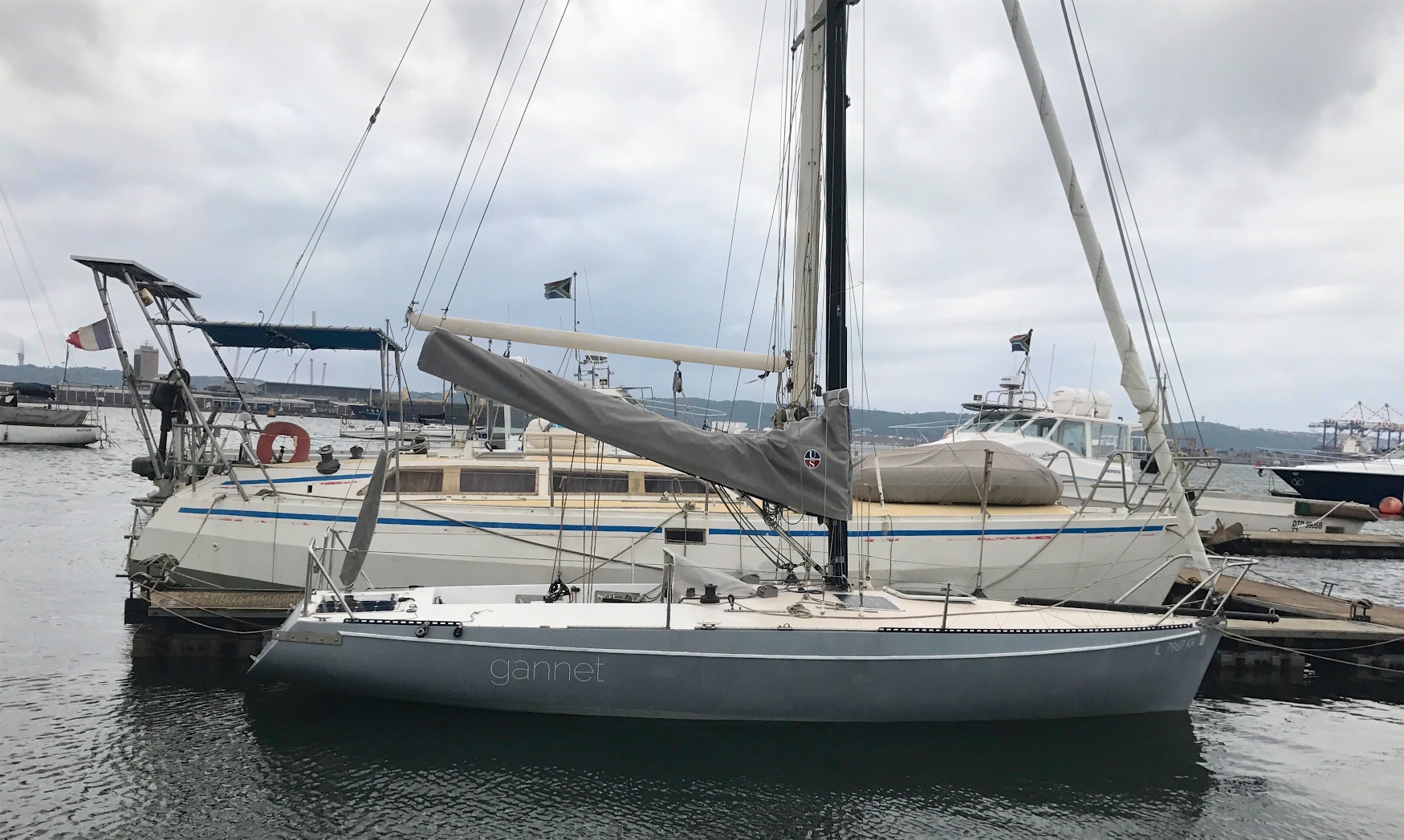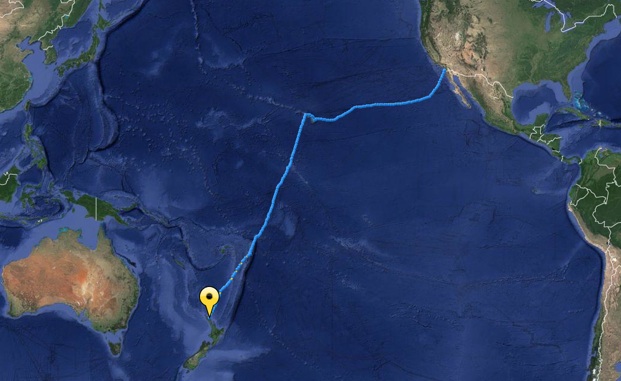GANNET is on one of 22 or 23 moorings put down for visiting yachts at St. Helena Island in the South Atlantic Ocean, about 2/3s of which are full. When I was here 29 years ago you had to anchor in very deep water and use your dinghy to get ashore, which with a lot of surge was an adventure. There is still a lot of surge and intermittent 20 knot gusts of wind. One of those gusts blew a Sportaseat overboard. I heard it go, but it was already out of reach and on its way north. This isn’t a harbor, just an indentation on the lee side of the island. The moorings are off a several hundred foot high cliff. Lots of terns flying up there where I assume they nest.
I didn’t try to go ashore the day I arrived, but stayed on board and sorted things out and had a fresh water solar shower and put on clean clothes.
The passage from Durban, South Africa, seemed longer than 23 days, perhaps because the parts were so different.
The weather this year never provided even 72 hours of fair wind along the South African coast. I got tired of waiting and decided to make this an ocean passage rather than a coastal one, and went to sea intending to stay there rather than harbor hop. I expect that GANNET was the smallest boat to clear into Durban this season. I am certain she was the only one to clear for St. Helena. The Immigration officer asked me where it is. Sorry, Napoleon.
Along the South African coast GANNET had her best day’s run ever, an Agulhas Current assisted 180 miles. I was routinely seeing SOGs of 12 and 13 knots when we were sailing 8 and 9. And six days later her slowest day of only 13 miles, when we lay ahull for 12 hours in 20-30 knot headwinds and then were becalmed for 12 hours forty miles off Cape Agulhas, which we passed three times, two sailing west, one drifting back east. We could have sailed against the headwinds, but would have been beaten up and I chose to wait rather than suffer unnecessarily and unproductively.
Once clear of Cape Agulhas and the Cape of Good Hope, we had mostly good sailing except for a couple of days of gale force winds when we again lay ahull. When those winds first reached us during the night I saw an SOG of 14.1 knots before I could reduce sail, the highest I have ever seen on GANNET, though she may have gone higher when I wasn’t looking. Two waves caught us and knocked us down, at least one of which put the masthead in the water because the Windex up there is broken. That Windex was new in Durban, a replacement for one broken last year in a masthead-in-the- water knockdown in the Indian Ocean. GANNET is hard on Windexes. The electronic masthead unit is still working.
The last week was easy trade wind sailing. I could have gone faster, but just let GANNET ease along under jib alone. I’ve done a lot of hard. Easy was nice.
I expect to be here until March 14. I’d like to get laundry done and need to change water. The water in my jerry cans has stuff growing in it. I’d also like to replenish some essential supplies. I’m short of paper towels and gin.
I need to remove everything from the v-berth, dry it out, and reorganize the stowage. Several bags up there and the water jerry cans are tied in place, but even so knockdowns are mighty shifters.
I will inflate and dry out the Avon, which hasn’t been used since Darwin, though it has gotten wet and I expect is moldy.
GANNET didn’t take a lot of water below, except in the knockdowns. The spray hood definitely helped. So far it has been exactly what I hoped. I do have a couple of leaks that I’ll try to find. But basically the little boat and I are in good shape.
Two Raymarine tiller pilots have died. The Pelagic tiller pilot performed flawlessly even surviving the gale knockdowns. I don’t use it all the time because it is noisier than the Raymarines. I did use sheet to tiller part of the time.
I haven’t looked at the Yellowbrick tracking page, but saw from some emails that it uploaded as it was supposed to. I also sent and received three emails from Carol, who is the only one who has that address. I carry Carol with me everywhere, including the monastery of the sea. The Yellowbrick email worked flawlessly. On some past passages there was a software problem. The Yellowbrick now shows 53% charge.
I like St. Helena very much. It is remote, quaint, and unchanged ashore from when I was here in 1988. An airport has been built at a cost of more than three hundred million dollars and was supposed to open last year, but almost unbelievably they built it in the wrong place, on the edge of the cliffs on the windward side of the island where turbulence from the trade winds meeting those cliffs makes landings and takeoffs unacceptably dangerous. How such a mistake could be made by presumably professionals boggles the mind. In any event, when any of the 4,000 residents of St. Helena see an unfamiliar face they still know you’ve sailed there on your own and are charmingly friendly.
St. Helena’s land moved exceedingly beneath my feet for the first few hours I was ashore.
On this passage we moved from the Eastern Hemisphere to the Western. On the next we will move from the Southern to the Northern. Time and chance permitting, next stop St. Lucia, 3800 miles distant, bearing 295º.
If we make it, we will have done more than half the planet since Darwin, Australia, with two stops, Durban and St. Lucia. Darwin 131ºE. St.Lucia 61ºW.
I didn’t even plan that. It may just happen.
Go GANNET.
I do not share the Disneyesque ‘if you wish upon a star’ delusion. Many things are impossible. But much more is possible than most people think. Many, perhaps even most, limitations are self-imposed. So if you want to do what has never been done and go to the edge of human experience, don’t impose limitations on yourself and don’t let anyone else impose them on you, Plan, calculate risk, prepare to the extent of your resources. Give yourself ample time. Don’t do things at the last minute.
People often praise me for my courage. I have never claimed to be courageous. Courage is doing something you are afraid to do. People think I have courage because I do things they are afraid to do. Nerve is the willingness, after planing, calculating and preparing, to embark on an endeavor whose outcome is uncertain and may be fatal. So if after that preparation, you have the nerve, go.
Trust all is well on the mainland. I heard no news while at sea—a pleasure—and haven’t bothered to catch up since I arrived.











